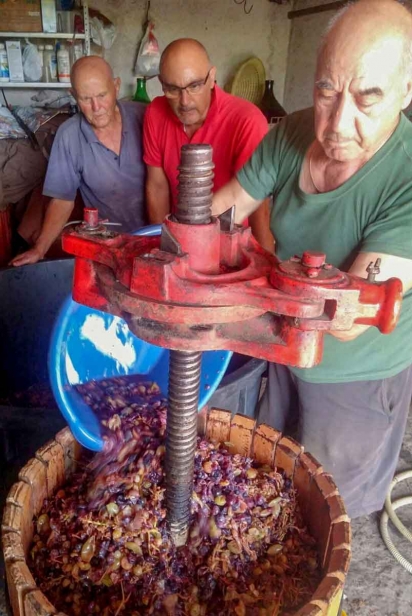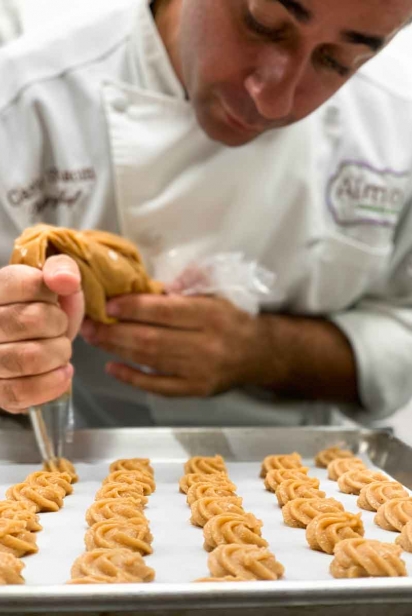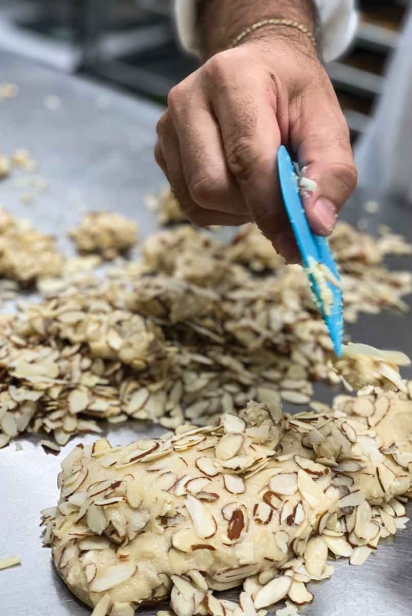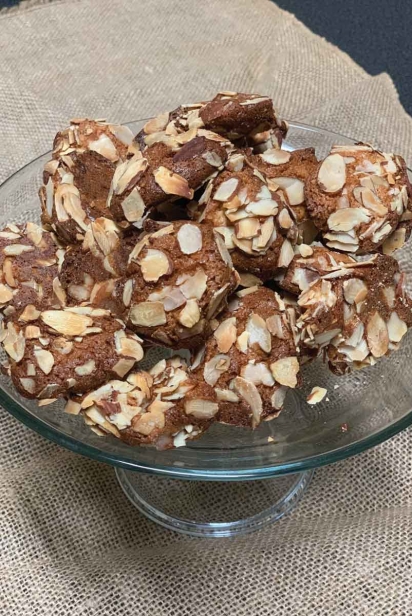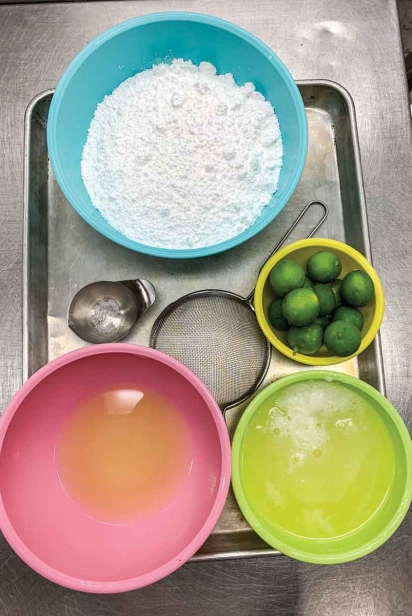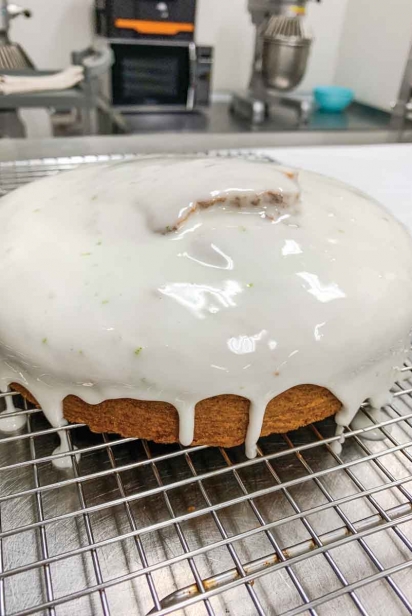Third-generation Sicilian Baker: For Love of Family
One day, over a bottle of pinot noir, a couple dreamed up a bakery called Almotti, a combination of “almond” and “biscotti” – where they would sell classic Italian cookies.
As a young boy in Viagrande, a Sicilian village not far from the smoking peak of Mount Etna, Carlo Raciti would read recipes from loose pages of an old family cookbook. Baking ran in the family – his grandmother started a bakery during World War II because she needed to make a living, and his father did deliveries by bicycle. “My father tried to push me away from the business,” recalls Raciti, now 37, but it didn’t stop him from choosing a career. He went to school to study hospitality and ultimately become a pastry chef.
Twelve years ago, Raciti and a group of friends from Sicily came to Miami on a two-month break, when met his future wife, Rebecca Bechara, playing pool at Purdy Lounge. She won the game and his heart. Racici returned to Sicily and came back to Miami two weeks later by himself with 500 euros in his pocket. He proposed, and she said yes.
Italy Break
After getting married, life was a whirlwind. While Bechara worked in retail in Miami Beach, Raciti took a job with a tour operator while doing Sicilian-style catering on weekends. Along came their son, Mario Carlo, and both decided to take off a year and move to his family’s house in Sicily to raise their son and experience firsthand Italian customs and life. They also took the time to dream about their future.
“We were planning to do a retail bakery in Miami Beach,” says Raciti. When they returned, they started looking. But space turned out to be very expensive. After four months, they tried a new approach: “Let’s see what clients think of our product.” They came up with a line of bite-sized, melt-in-your-mouth almond macaroons, invested $500 in a tent, baked their cookies in the garage, and did their first market on Lincoln Road. Their cookies promptly sold out. Then came Normandy Village and the Government Center markets.
The Market Life
At the time, all Almotti cookies were not gluten-free. But because customers were asking, they decided to switch to only gluten-free cookies, Raciti says. Whatever their food sensitivities, people just liked the cookies, which are not overly sweet but full of flavor. “People can have a sweet that is not just sugar,” he says. They added markets at Aventura, the University of Miami, Legion Park, even Boca Raton. They built out a new shop and baking space in Kendall and hired staff to meet the demand of baking, packaging and filling orders. “There was a time I was not stopping,” he says. “Monday to buy ingredients, Tuesday baking, Wednesday baking and delivering, Friday baking, helping in the kitchen, delivery, more accounts …” he recalls. One day, after coming in at midnight, his wife and business partner issued an ultimatum. He was missing too much of family life. Wholesale would offer more flexible hours.
They stopped doing most of the markets, focusing instead on building new accounts, including Milam’s Markets, Norman Brothers and The Golden Hog. They continued doing local festivals like Carnaval on the Mile, Beaux Arts at UM and the St. Stephen’s Art and Craft Show in Coconut Grove, where they were named Maker of Merit this year.
These days, the couple has settled on a balance of sorts. Bechara works behind the scenes, on the website, marketing, accounting and presentation (“she is the boss,” he says), while Raciti and staff turn out 30,000 cookies a week. Next steps: getting gluten-free certification, an expensive process they believe is essential to growing their brand nationally; and attending the Summer Fancy Food Show in New York. After that? “I would like to start a retail bakery one day,” says Raciti. “But Mamma always says: Rome wasn’t built in a day."
Harvest Time in Sicily
Growing up in the small town of Viagrande, Raciti recalls family traditions during harvest time that remain today. Everyone gets together to can ripe tomatoes to use throughout the year. “We buy 100 kilos of tomatoes, add salt, boil them 1-2 hours, pass through a mill to remove the skins and seeds,” as his wife, Rebecca, is doing below. To make olive oil, his father would harvest the olives and put them in a press, then bottle the oil. “Just 20 liters for family use,” he says. “I would make it last all year.” The most festive celebration is reserved for winemaking. The entire family would spend all day picking grapes – Nerello Mascalese, a dark-skinned variety that grows on Mount Etna. The following day, they put the grapes in a manual press and squeeze. “In the beginning, it’s easy, so the kids start first,” he says. “Then my father, my cousin Aldo – extra power!”
The first grape juice, the mosto, is mixed with sugar and a little ash from the branches that acts as a starch, forming a treat called mostarda siciliana. When the work is done, everyone gathers for a typical feast: pasta with sauce, barbecued sausage and steak, served with salmoriglio, a condiment made with extra-virgin olive oil, lemon, vinegar, salt, pepper and parsley. For dessert, there’s cassata siciliana, a traditional sweet made from fresh ricotta, candied fruit and sponge cake. Food draws everyone together, as it has for hundreds of years. “Family is the most important thing,” says Raciti.
In the Kitchen
Something good is always cooking at the Almotti shop, where Raciti and his staff bake, package and sell and prepare for delivery all of their cookies and cakes. Since they are gluten-free, almond meal from a farm in California is used in some of their cakes and many of their amaretti. Raciti pipes his guava amaretti. For croccante, he rolls the soft dough in sliced almonds and cuts it in irregular pieces. The finished product is crunchy and satisfying, but not too sweet. To ice his torta al limone, Raciti has his ingredients ready: confectioner’s sugar, key limes, pasteurized egg whites, lime juice and salt. Raciti whisks together the sugar and lime juice until it’s glossy. Lime zest adds flavor and bits of color in the final cake.
Bags of cookies come in three sizes, priced at $4.99 to $12.99. All are gluten-free and dairy-free, except for Gocce di Cioccolato, which contain butter. Cookies include Classico Soft Amaretti, made with almond meal and honey; Croccante, covered with sliced almonds instead of powdered sugar; Al Guava, with tropical guava; Classico al cioccolato, with almond meal, honey and cocoa; Meringhe (meringues); and Al Cocco, a coconut macaroon. Cakes include Torta al limone, di mela (apple), guava, pecan, almond, coconut, mango (in season), and torta intenso, flourless almond and dark chocolate cake. Prices range from $30-40.
Almotti Gluten-Free Italian Delicacies
almotti.com
Almotti gluten-free Italian delicacies are sold in his shop near Tamiami Airport in West Kendall, online and at groceries, including Milam’s Markets, Norman Brothers in Kendall, The Golden Hog in Key Biscayne, Marky’s Gourmet in Little River, Baptist Hospital, Mima Market in Miami Shores and Babe’s Meat and Counter in Palmetto Bay.





